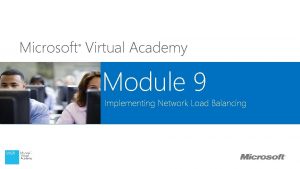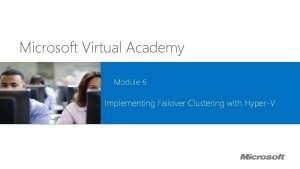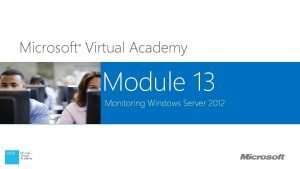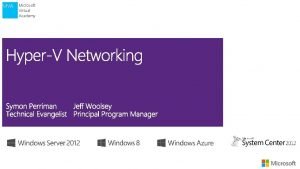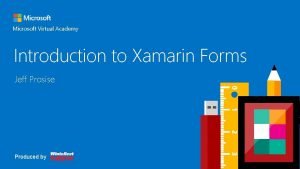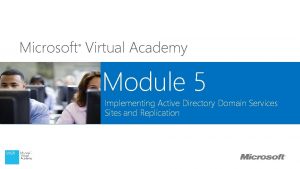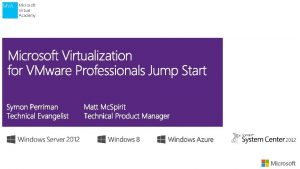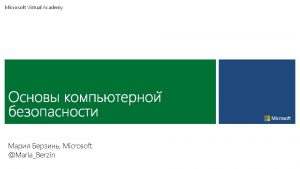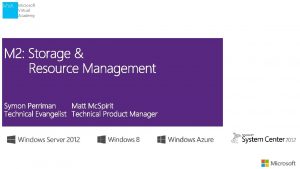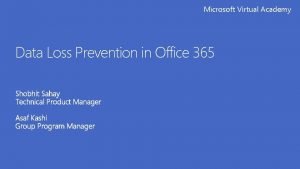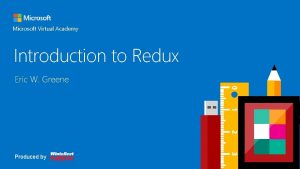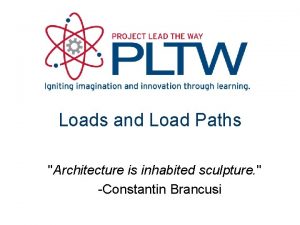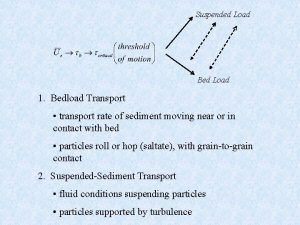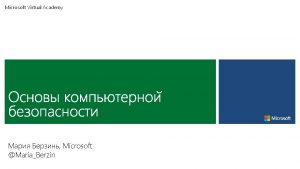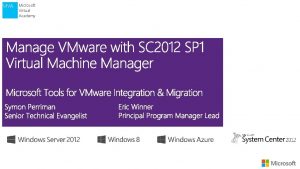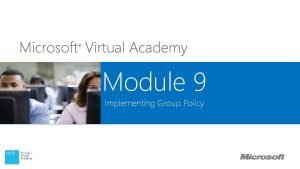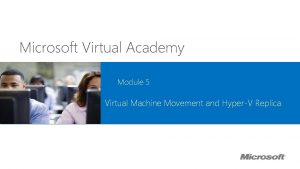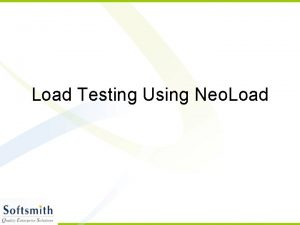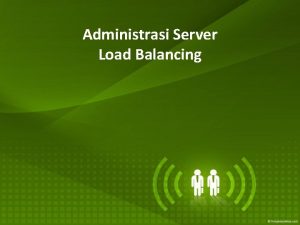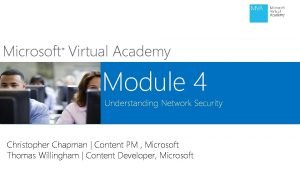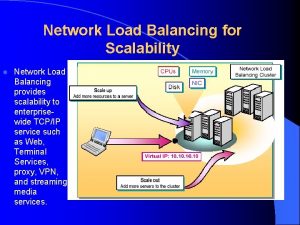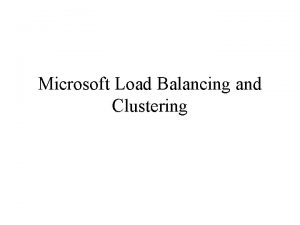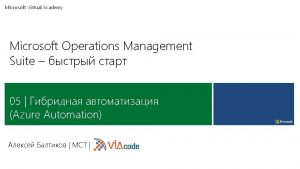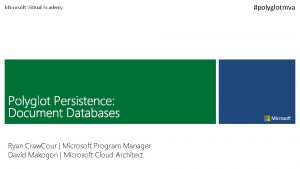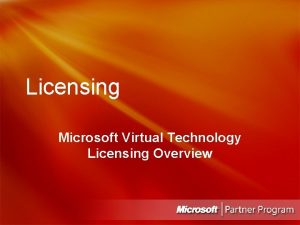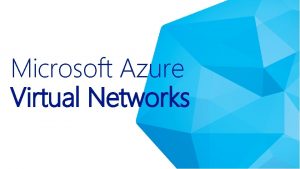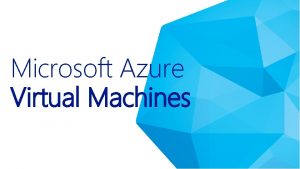Microsoft Virtual Academy Module 9 Implementing Network Load























- Slides: 23

Microsoft Virtual Academy ® Module 9 Implementing Network Load Balancing

Module Overview • Overview of NLB • Configuring an NLB Cluster • Planning an NLB Implementation

Overview of NLB

Lesson 1: Overview of NLB • What Is NLB? • How NLB Works with Server Failures and Recovery? • NLB Features in Windows Server 2012 and Windows Server 2012 R 2

What Is NLB? • Scalable high-availability technology • Balances traffic based on node utilization • New traffic will be directed to the node that is being utilized the least • You can configure NLB to preference some nodes over others • Used with stateless applications such as: • Web tiers of multi-tier applications • Not used with stateful applications such as: • Traditional file servers • Database servers

How NLB Works? Accept? No Network Load Balancing Host Dedicated IP: 10. 1. 1. 3 Virtual IP: 10. 1. 1. 1 Network Load Balancing Host Dedicated IP: 10. 1. 1. 4 Virtual IP: 10. 1. 1. 1 Accept? Client Network Load Balancing Host Dedicated IP: 10. 1. 1. 2 Virtual IP: 10. 1. 1. 1 Yes Accept? No Network Load Balancing Host Dedicated IP: 10. 1. 1. 5 Virtual IP: 10. 1. 1. 1

How NLB Works with Server Failures and Recovery? NLB cluster heartbeats are transmitted every second between nodes in a cluster Convergence occurs when: A node misses five consecutive heartbeats, at which time it is automatically removed from an NLB cluster • A node that was member of a cluster returns to functionality • An administrator adds or removes a node manually •

NLB Features in Windows Server 2012 and Windows Server 2012 R 2 Use 35 new NLB Windows Power. Shell cmdlets to manage all aspects of NLB configuration • Use Nlb. Cluster noun to manage the cluster • Use Nlb. Cluster. Node noun to manage individual nodes

Configuring an NLB Cluster

Lesson 2: Configuring an NLB Cluster • Deployment Requirements for NLB • Demonstration: Deploying NLB • Configuration Options for NLB • Demonstration: Configuring NLB Affinity and Port Rules • Network Considerations for NLB

Deployment Requirements for NLB • All hosts must be on the same subnet • All adapters must be configured as either unicast or multicast • Only TCP/IP protocol can be used on adapters • All adapters used with NLB must be configured with static IP address

Demonstration: Deploying NLB In this demonstration, you will see how to create a Windows Server 2012 R 2 NLB cluster

Configuration Options for NLB Port rules determine how traffic is directed to cluster nodes depending on TCP or UDP port • Multiple hosts • Single host • Disable port range Affinity settings determine how reconnection occurs • None • Single • Class C

Demonstration: Configuring NLB Affinity and Port Rules In this demonstration, you will see how to: • Configure affinity for NLB cluster nodes • Configure NLB port rules

Network Considerations for NLB Unicast mode • Suitable for clusters that have multiple network adapters Multicast mode • Suitable for NLB clusters that have single network adapters • Network devices must support multicast MAC addresses IGMP multicast • Improves switch performance • Requires a network switch that supports this functionality

Planning an NLB Implementation

Lesson 3: Planning an NLB Implementation • Designing Applications and Storage Support for NLB • Considerations for Deploying an NLB Cluster on Virtual Machines • Considerations for Securing NLB • Considerations for Scaling NLB • Considerations for Upgrading NLB Clusters

Designing Applications and Storage Support for NLB • Each node in an NLB cluster needs to have the same configuration • Each node needs access to the same consistent application data • Use IIS shared configuration to ensure that web application configuration is consistent across NLB nodes • Use CSVs to host shared application and configuration data for NLB applications

Considerations for Deploying an NLB Cluster on Virtual Machines • Configure virtual machines with multiple network adapters • Configure one network adapter on each node member to use a shared private network switch • Configure the NLB cluster to use unicast mode and enable MAC address spoofing on Hyper-V host • Use the shared private network switch for cluster communication • When NLB nodes span multiple sites, use network virtualization to separate the cluster network

Considerations for Securing NLB • Use NLB cluster port rules to discard traffic not related to cluster applications • Use firewall rules on cluster nodes to drop traffic not related to cluster applications or node management • Configure applications to respond only to traffic that is addressed to the cluster • Use SANs to create certificates that support the application name and node names • Implement principle of least privilege to ensure that only authorized users have appropriate permissions on nodes

Considerations for Scaling NLB clusters can have up to 32 nodes Use DNS round robin to distribute traffic between NLB clusters Netmask ordering Client in Sydney Cluster in Canberra Client in Brisbane Cluster in Melbourne DNS round robin

Considerations for Upgrading NLB Clusters NLB clusters can run with different operating systems • Windows Server 2012 R 2 NLB clusters can interoperate with: • Windows Server 2003 & Windows Server 2003 R 2 • Windows Server 2008 & Windows Server 2008 R 2 • Windows Server 2012 • Piecemeal upgrade: • Add Windows Server 2012 R 2 cluster nodes • Remove nodes running earlier operating systems • Upgrade clusters: 1. Remove node from NLB cluster 2. Upgrade to Windows Server 2012 R 2 3. Rejoin node to NLB cluster

Additional Resources & Next Steps Instructor-Led Courses • 20412 C: Configuring Advanced Windows Server 2012 Services Books • Exam Ref 70 -412: Configuring Advanced Windows Server 2012 Services Exams & Certifications • Exam 70 -412: Configuring Advanced Windows Server 2012 Services
 Microsoft virtual academy free courses
Microsoft virtual academy free courses Microsoft virtual academy
Microsoft virtual academy Microsoft virtual academy
Microsoft virtual academy Microsoft virtual academy
Microsoft virtual academy Microsoft virtual academy free online training
Microsoft virtual academy free online training Microsoft virtual academy
Microsoft virtual academy Microsoft virtual academy
Microsoft virtual academy Microsoft virtual academy free courses
Microsoft virtual academy free courses Live migrate
Live migrate Virtual academy microsoft
Virtual academy microsoft Microsoft virtual academy active directory
Microsoft virtual academy active directory Microsoft mcsa private cloud
Microsoft mcsa private cloud Ms virtual academy
Ms virtual academy Chander dhall
Chander dhall Microsoft virtual academy
Microsoft virtual academy Microsoft online academy
Microsoft online academy Microsoft virtual academy python
Microsoft virtual academy python Virtual academy microsoft
Virtual academy microsoft Virtual circuit vs datagram networks
Virtual circuit vs datagram networks Taper roller bearing advantages and disadvantages
Taper roller bearing advantages and disadvantages Tributary load and load path
Tributary load and load path Suspended load definition
Suspended load definition The point of intersection of dc and ac load line is called
The point of intersection of dc and ac load line is called C device module module 1
C device module module 1

